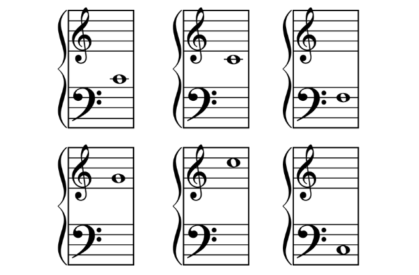Colourful Keys is primarily a blog for music teachers. However, this article is part of a series for PARENTS of music students. If you’re a music parent, read on to learn why a lot of teachers no longer teach note names using mnemonics. If you’re a teacher, feel free to pass the link to this article on to parents in your studio.
If you had any musical training as a child – whether general music class in school or outside music lessons – you were probably taught the names of notes by using mnemonics or acronyms. (Every Good Boy Does Fine, anyone?) But will those tricks really help your kids learn to read piano music?

First things first: If you never learnt acronyms for note names on the staff (such as “All Cows Eat Grass”) and you think I’m crazy for talking about cows at all, you can stop reading here. 🐮
But if those silly sayings are familiar to you, keep reading.
Because while teaching your piano kiddos those same music mnemonics might seem easy and helpful, we know now that those mnemonics tend to hinder their reading progress more than help.
What’s wrong with using music mnemonics?
The problem with mnemonic devices for music, in particular, is that they’re the slowest method of figuring out a note name. To use a mnemonic you need to go through these steps:
- Select the correct mnemonic for this clef (treble or bass) and line/space notes.
- Say the mnemonic to yourself while working up the stave.
- Think of the letter that starts the word you landed on.
- Find this note on the piano.
This is extra cumbersome if you’re a child and can’t even spell the words quickly.
How We Read Piano Music
The surprising truth is, we don’t really need to know all the note names in order to read and play piano music. We actually read piano music in patterns. We don’t stop and think: “That’s an A. OK, next I’ll play a B.”
We don’t do that because it would be impossible to do it quickly enough to actually play music. 🤯
So even if you consider mnemonics to be a great way to remember note names, note names aren’t very important when first learning to read piano music.
Landmark Notes
Imagine someone asks you for directions from the shopping mall to the primary school. From the outset, you have to know where the shopping mall is: the starting landmark.
The same holds true for finding your way around the lines and spaces of the staff. In the beginning, teachers often want your kiddos to learn the names of just 3 to 5 landmark notes.

As long as your child can find the landmark notes their teacher assigns, they can navigate their way around the rest of the staff.
Patterns and Intervals
Let’s continue with our analogy of giving directions from the shopping mall to the primary school. You’ve already established where that landmark shopping mall is. Now, how do you help your friend make their way to the school?
It probably goes something like this: “Walk 2 blocks south then turn right. When you get to the stoplight, go 3 more blocks and the school will be just across the street.”
Reading music on the staff is similar to finding your way around the neighbourhood.
Once your child knows where to start their piece (from those landmark notes we talked about), they simply need to see if the notes are going up or down and by how far. That distance between 2 notes is called an interval.
If your child is just starting out, they’re probably learning steps and skips on the staff. Down the road, they’ll learn to read notes that are farther apart than that.
Are you ready to let go of the music mnemonics?
It’s not that we don’t want your child to learn the note names; it’s just not a priority in the beginning. Help your child commit those landmark notes to memory then read the rest in patterns, and they’ll be reading music in no time!
Feel free to leave your questions in the comments, and we’ll do our best to help.